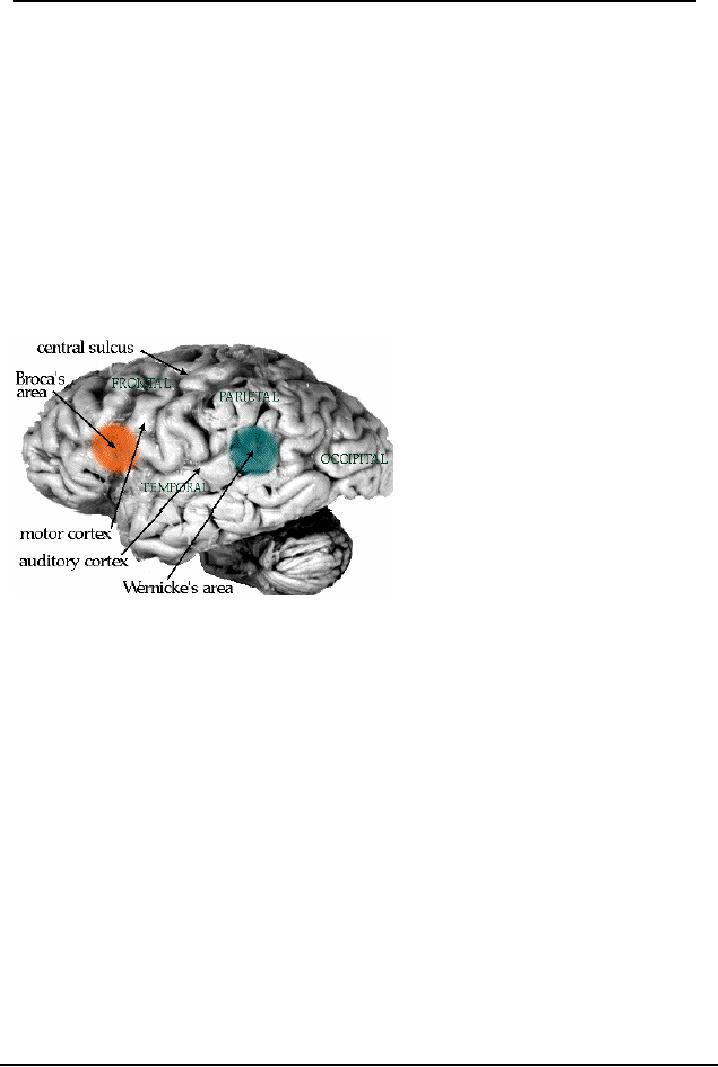 |

Neurological
Basis of Behavior (PSY -
610)
VU
Lesson42
Higher
Order Brain
functions
Objectives:
The
students would be familiarized
with the role of higher
order brain functioning.
This is the role of the
highly
evolved areas of the brain, the cerebral
cortex.
Brain
correlates
�
a)
Language
Speech Production Comprehensions,
Aphasias
�
b)
Visuospatial,
The man who mistook
his wife for a
hat?
�
c)
Apraxias.(
Neuropsychological tools)
�
d)
Brain
correlates of Learning and Memory,
Amnesia, Verbal, Non verbal
memory,
�
e)
(Neuropsychological
tools)
When
we refer to the higher order
functioning we are focusing on the
cortical control of
major
functions.
As we stated in our earlier
chapters, the higher the animal on the
evolutionary scale the more
the
cerebral cortical control over
these functions and development of newer
functional connections.
Behavioral
neurosciences is attempting to
�
Understand
functions such as language, emotions,
learning, memory and
psychopathology,
�
Develop
models to explain the function of
cortical areas as they
relate to behavior
We
would discuss language which
humans have evolved as specialized
communication. This is not
just
communication
but language is intertwined with
development of healthy and
pathological behaviors
Language
This
is among the most important higher
order function, and is
uniquely human but not so,
because if
we
look around us we can see
examples of communication in other
animals as well. For example,
Bird
songs
dog's growling are complex
communication system, with the
variation - which can
communicate
the
state of one dog to another even
across species communication
can take place through
these
signals.
165

Neurological
Basis of Behavior (PSY -
610)
VU
In
the squirrel monkeys language comes under
limbic control, in humans
vocalization is both
limbic
(non
verbal: cries, groan,
gasps,) and cortical (: verbal, and
symbolic). The development of
language
is
based on capabilities already
present in the nervous system.
Therefore
the evolution of language involves
�
Appropriate
development and evolution of
cognitive and communication abilities
and
apparatus.
The abilities of primates are
limited with categorization of calls
i.e. the alarm calls
are
different from the mating calls.
These do not have the sophisticated
mechanism for
variation
as humans have.
�
A
structure of language in a formal system of
signs and symbols
�
Development
of the language in children who have the
capability of doing so
Speech
is difficult (fairly impossible)
for a non human primate and
young humans as the
appropriate
mechanisms have not developed
physically. It is only about
50,000 years ago the
tracts
and
physical apparatus for language
evolved (this is controversial and the
brain and language
capabilities
must have evolved
together).
Language
in Non Human
Primates.
Communication
Non human primates: primitive, gestures,
postures, (more non verbal) calls
of
different
types: alarm, distress, territoriality
threat but not complex
communication such as,
how
are
you today? This is not
possible for animals even the higher
order primates (except for
humans).
In
innovative experiment carried
out by Gardiner and Gardiner
where they trained a
chimpanzee
Washoe
to communicate with humans using the
American Sign Language. The
chimpanzee learnt
over
a hundred signs and exhibited
capability of communication equivalent to
two years (human)
with
"slot grammar" such as a human
child would use: long
darkness for tunnel. However
this
chimpanzee
was not able to
verbalize.
In
primate's one call, one
sound is communicating one message,
whereas human language uses a
combination
of a few sounds to lead to
thousands of words (with intonations
entirely different
interpretation,
grammatical limitations and boundaries.
The same sound uttered in
different ways in
different
situation leads to a different
interpretation
However,
many experimenters such as Premack and
Premack have led us to rethink.
First and
foremost
man and chimpanzee share
96% genes it is possible that
chimpanzee can develop
language
as
humans did.
Lana,
a chimpanzee at the Yerkes Primate
Institute, developed grammatical
relationships on her
own
such as saying "Lana wants
banana" and connected novel strings of
symbols using computer
and
other symbols, innovation in picking up
and expanding on the learnt words
demonstrated that
there
were capabilities in the primates closest to
humans. There was not
much learning by
interaction
and socialization
We
must understand that language development
requires learning by interaction and
socialization.
How
does a child learn a language?
Through imitation and reinforcement of
the words expressed till
they
become meaningful and can get the desired
objects such as candy or food.
Even human
children
if brought up without such
stimulation do not develop language even
though they have the
capability
of doing so. For example
children reared by wolves
don't have the human language;
they
can
only communicate like the wolves by
snarling, growling or
barking.
166

Neurological
Basis of Behavior (PSY -
610)
VU
Speech
Production and Comprehension (Carlson and
Pinel)
In
order to understand speech we move
through the absence of speech.
Stroke, accident or any
other
traumas
which lead to loss of
speech.
One
of the disorders of speech is Aphasia
which is disorder of comprehension or
production of
speech
Speech
production: is based on several
abilities: sensation and perception of
the surrounding,
memories
and imagination; connection between past
and present, vocal capabilities,
articulation
musculature.
Paul
Broca a French neurologist described a patient
who had great difficulty in producing
speech.
Broca
described the cases of 14 patients at a conference
and his paper went
unnoticed. These were
stroke
patients who had middle cerebral arterial
supply of blood to the Sylvain fissure
affected
leading
to similar difficulties. He then
identified this area as
inferior prefrontal
cortex
Broca's
aphasia( Aphasia: Greek word, A: without,
phasia: speaking out): Broca's
area in the
frontal
lobe controls the musculature and other
mechanisms (air vibrating in the
vocal cords) and
damage
to inferior left frontal
lobe, The Broca's area
contains motor memories of tongue,
lips, jaw,
coordinated
and sequenced movements. It lies adjacent
to the controls of face and lip,
though the
posterior
parts of Cerebral Cortex
want to say it but the
frontal damaged area makes
it difficult
Brocas
aphasia: is mainly a
disorder of expressive speech. This
results in slow laborious
and non
fluent
speech. Broca's aphasics
make an effort to locate words to express
what they want to
say,
they
mispronounce words but usually come
out with meaningful
sentences. These aphasics
have
difficulty
in small grammatical mistakes
such as the use of a, the, some,
in, about (linking
words)
They
can articulate little words
with grammatical meanings: Function words
are difficult, but
content
words come easily, as they
can convey what the patient
is trying to say, "Ah Monday, Ah
DAD,
Paul and Dad, hospital...
Wed.... 9p.m. (Goodglass 1976, p 278 cf
Carlson 1994 and
Bridgeman
1988)
Their
speech is telegraphic, and there is no
impairment of speech comprehension
A
series of Neuropsychological tests
which can assess Broca's
aphasia are for
example:
A
picture is shown to the patient where a
horse and a cow are standing
in the same posture. In one
picture
the cow is kicking the hind
leg of the horse with its
hind legs, and the second picture
the
kicking
is reversed. There are questions of
what is happening who is
kicking who and where?
The
correct
grammatical order is required (Shwartz,
Saffron and Marin
1980)
Task
sequencing commands are also
given, word order is
disrupted because they
difficulty in
carrying
out a sequenced response. If
this area is stimulated it
leads to a coordinated movement,
lesioning
blocks the coordinated sequence.
Questions can be "Pick up a red
ball and touch green
circle,"
difficulty in saying it is difficulty of
muscles of speech
production.
Speech
Comprehension
In
Speech Comprehension the areas in the
auditory lobe are involved.
Wernicke's area is located in
the
Middle and Posterior region of
Superior Temporal
Gyrus.
The
speech comprehension area collects
information, matches, recognizes, and
analyzes it and sends
it
to the articulation areas (through the
arcuate fasciculus). Recognition of a
word involves
167

Neurological
Basis of Behavior (PSY -
610)
VU
a)
Sensation,
b)
Perception
c)
Memories
of the sequencing of sound
articulation.
Damage
to this region leads to
receptive speech
disorder
Primary
characteristic of Wernicke's aphasia is
that the speech appears
better than Broca's
fluency
rhythm
as the articulation intact but
what they say does
not make sense. However,
they cannot recognize
the
deficit. Poor speech comprehension and
production of string of meaningless words
characterizes
Wernicke's
aphasia. Wernicke's patients are
not aware of their problems
with speech.
Wernicke's
patients
not aware of their problems
are speech. They are
not aware that people
don't understand them,
or
they are having any
difficulty. What they say or
hear is incomprehensible to them and
others
Speech
appears correct to a foreigner but to
those who know the language it is
nonsensical. As an
example,
When
asked what do you
do?
The
patient replies, "Mista
oxycge,wann tell happened
when happened, herent, kell, cam
ho, renrapiers"
and
the patient is satisfied that he
was answering the
question
The
neuropsychological tests for
speech comprehension e.g. the Patient
tested through questions of
receptive
speech: point to pen, your
nose,
The
deficit is at the semantic level
(meaning of the words) their
deficit is in understanding speech
and
its
meaning
References:
1.
Carlson N.R. (2005) Foundations of
Physiological Psychology Allyn and Bacon,
Boston
2.
Pinel, John P.J. (2003)
Biopsychology (5th edition) Allyn and Bacon
Singapore
3.
Bloom F, Nelson and Lazerson (2001),
Behavioral Neuroscience: Brain, Mind
and Behaviors (3rd
edition)
Worth Publishers New
York
4.
Bridgeman, B (1988) The
Biology of Behaviour and Mind. John
Wiley and Sons New
York
5.
Brown,T.S. and Wallace.(1980) P.M
Physiological Psychology
Academic
Press New York
6.
Bradshaw J.L. and Mattingley, J.B.
(1995) Clinical Neuropsychology:
Behavioral and Brain
Sciences.
ACADEMIC PRESS
Note:
References
2, 5, 6 more closely followed in addition
to the references cited in
text.
168
Table of Contents:
- INTRODUCTION:Descriptive, Experimental and/ or Natural Studies
- BRIEF HISTORICAL REVIEW:Roots of Behavioural Neurosciences
- SUB-SPECIALIZATIONS WITHIN THE BEHAVIORAL NEUROSCIENCES
- RESEARCH IN BEHAVIOURAL NEUROSCIENCES:Animal Subjects, Experimental Method
- EVOLUTIONARY AND GENETIC BASIS OF BEHAVIOUR:Species specific
- EVOLUTIONARY AND GENETIC BASIS OF BEHAVIOUR:Decent With Modification
- EVOLUTIONARY AND GENETIC BASIS OF BEHAVIOUR:Stereoscopic vision
- GENES AND EXPERIENCE:Fixed Pattern, Proteins, Genotype, Phenotypic
- GENES AND EXPERIENCE:Mendelian Genetics, DNA, Sex Influenced Traits
- GENES AND EXPERIENCE:Genetic Basis of behavior, In breeding
- GENES AND EXPERIENCE:Hybrid vigor, Chromosomal Abnormalities
- GENES AND EXPERIENCE:Behavioral Characteristics, Alcoholism
- RESEARCH METHODS AND TECHNIQUES OF ASSESSMENT OF BRAIN FUNCTION
- RESEARCH METHODS AND TECHNIQUES OF ASSESSMENT OF BRAIN FUNCTION:Activating brain
- RESEARCH METHODS AND TECHNIQUES OF ASSESSMENT OF BRAIN FUNCTION:Macro electrodes
- RESEARCH METHODS AND TECHNIQUES OF ASSESSMENT OF BRAIN FUNCTION:Water Mazes.
- DEVELOPMENT OF THE NERVOUS SYSTEM:Operation Head Start
- DEVELOPMENT OF THE NERVOUS SYSTEM:Teratology studies, Aristotle
- DEVELOPMENT OF THE NERVOUS SYSTEM:Stages of development, Neurulation
- DEVELOPMENT OF THE NERVOUS SYSTEM:Cell competition, Synaptic Rearrangement
- DEVELOPMENT OF THE NERVOUS SYSTEM:The issues still remain
- DEVELOPMENT OF THE NERVOUS SYSTEM:Post natal
- DEVELOPMENT OF THE NERVOUS SYSTEM:Oxygen level
- Basic Neuroanatomy:Brain and spinal cord, Glial cells, Oligodendrocytes
- Basic Neuroanatomy:Neuron Structure, Cell Soma, Cytoplasm, Nucleolus
- Basic Neuroanatomy:Control of molecules, Electrical charges, Proximal-distal
- Basic Neuroanatomy:Telencephalon, Mesencephalon. Myelencephalon
- Basic Neuroanatomy:Tegmentum, Substantia Nigra, MID BRAIN areas
- Basic Neuroanatomy:Diencephalon, Hypothalmus, Telencephalon, Frontal Lobe
- Basic Neurochemistry:Neurochemicals, Neuromodulator, Synaptic cleft
- Basic Neurochemistry:Changes in ionic gates, The direct method, Methods of Locating NT
- Basic Neurochemistry:Major Neurotransmitters, Mesolimbic, Metabolic degradation
- Basic Neurochemistry:Norepinephrine/ Noradrenaline, NA synthesis, Noadrenergic Pathways
- Basic Neurochemistry:NA and Feeding, NE and self stimulation: ICS
- Basic Neurochemistry:5HT and Behaviors, Serotonin and sleep, Other behaviours
- Basic Neurochemistry:ACH and Behaviors, Arousal, Drinking, Sham rage and attack
- Brain and Motivational States:Homeostasis, Temperature Regulation, Ectotherms
- Brain and Motivational States:Biological Rhythms, Circadian rhythms, Hunger/Feeding
- Brain and Motivational States:Gastric factors, Lipostatic theory, Neural Control of feeding
- Brain and Motivational States:Resting metabolic state, Individual differences
- Brain and Motivational States:Sleep and Dreams, Characteristics of sleep
- Higher Order Brain functions:Brain correlates, Language, Speech Comprehension
- Higher Order Brain functions:Aphasia and Dyslexia, Aphasias related to speech
- Higher Order Brain Functions:Principle of Mass Action, Long-term memory
- Higher Order Brain Functions:Brain correlates, Handedness, Frontal lobe